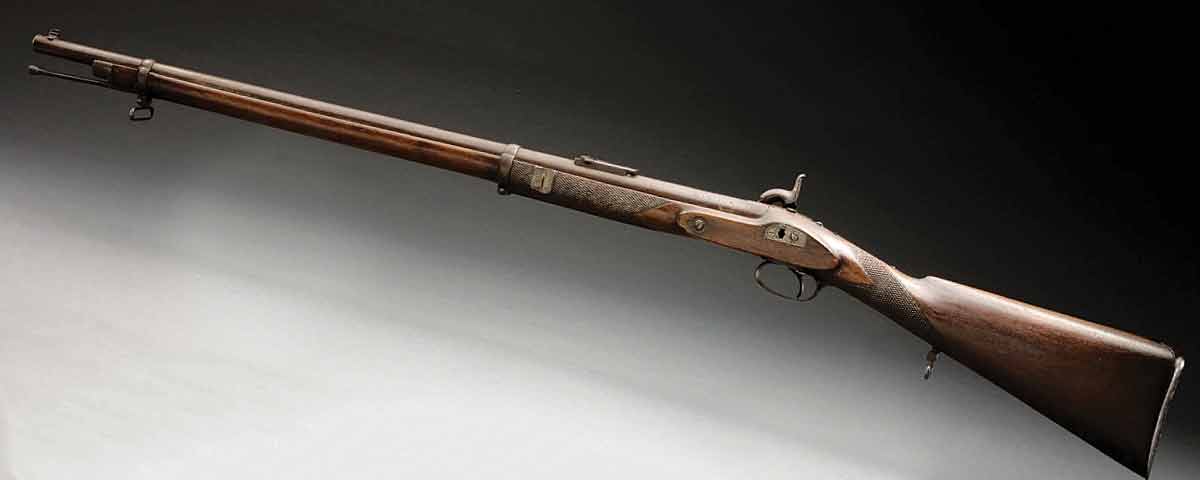[dropcap]F[/dropcap]rom hundreds of yards away, a Confederate sharpshooter carefully aimed his prized Whitworth, the crosshairs of its Davidson telescopic sight outlined against the ramparts of Fort Stevens in Washington, D.C. Through the scope—fitted to the left side of the stock—his eye scanned the ample crowd of Union soldiers and plucky civilians who had ventured by, hoping to observe warfare up close. Suddenly, the shooter’s attention shifted to a tall bearded man wearing a stovepipe hat, realizing it was that Yankee president, within easy range of his English-made precision rifle. As he prepared to fire, though, a Federal officer dragged Abraham Lincoln out of view.
This isn’t fiction. Lincoln actually came under fire on July 12, 1864, when Confederate Lt. Gen. Jubal Early’s Raid of Maryland reached Fort Stevens on the outskirts of the Union capital. Spent Whitworth bullets have been discovered in the vicinity, and we know sharpshooter rounds killed an officer a few feet away from the president. Had Lincoln been brought down, the Civil War may well have come to an entirely different conclusion, and an imported muzzle-loading rifle pressed into service by the Confederacy was the deadly tool that could have accomplished the job.
The Whitworth rifle claimed the lives of quite a few members of the Northern Army—artillerists, officers, and generals alike. But its impact in the war was limited, not by flawed design but because only a scant number managed to breach the formidable Union naval blockade of Confederate-controlled ports.
The story of this unusual shoulder arm begins in England with its namesake. Born in 1803, Joseph Whitworth showed a natural talent for mechanics at a young age. On completing school, he entered into an indentured apprenticeship in his uncle’s spinning mill with the intention of some day inheriting the business. He quickly mastered an understanding of the mill’s intricate machinery, often complaining about its lack of precision—an obsession that would distinguish him in time.
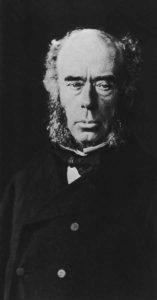
In 1833, Whitworth struck out on his own as a machinist, settling in Manchester, where he opened a shop and gained renown for high-quality tools like lathes. By mid-century, he was a wealthy, respected craftsman and president of the Institution of Mechanical Engineers.
During the Crimean War (1853-56), the British government turned to Whitworth for machine tools to manufacture its standard-issue .577-caliber Pattern 1853 Enfield rifle-musket, which the military was already thinking of replacing. Whitworth himself found its long-range accuracy unsatisfactory and believed he could design a better alternative.
For one, he thought the Enfield’s projectile was too short in proportion to its large-caliber diameter. A longer, smaller-caliber round, he theorized, would provide added surface area for the bore’s lands and grooves to grip, thus yielding more killing power at greater distances. He further maintained that the pitch of the gun’s rifling was too gradual and therefore placed insufficient spin on the bullet, affecting accuracy.
In 1856, Whitworth had produced a rifle and proprietary ammunition to address these weaknesses. Most important, his gun employed a bore with sharply pitched hexagonal rifling and a matching hexagonal, bolt-like projectile.
According to Whitworth, the ideal length of a rifle’s bullet was at least triple its diameter. The Enfield and the Whitworth rounds each weighed in at 530 grains (1.2 ounces); but, in contrast to the Enfield’s smooth, conical .577 caliber projectile, Whitworth’s was a sleeker .451-caliber with a hexagonal base that fit mechanically into the rifling of the gun’s 33-inch barrel (some Whitworth rifles featured barrels of 36 and 39 inches).
Locking into the bore’s grooves as a screw does threads, Whitworth’s bullet possessed an unprecedented twist rate when fired. Whereas the Enfield’s projectile rotated one full turn every 78 inches, Whitworth’s turned the same amount in 20 inches—nearly four times faster.
This gave Whitworth’s rifle several significant ballistic advantages for greatly improved accuracy: a blistering muzzle velocity of 1,200 feet per second versus the Enfield’s 900 feet per second; enhanced stability in flight; and, consequently, a flatter long-range trajectory. The cumulative effect was an undeniable asset to the marksman as it required less compensation for bullet drop at extended distances.
Using an indoor 500-yard range built for him by the British government to mitigate the effects of wind, Whitworth evaluated his theory. The longer .451-caliber Whitworth projectile possessed a better ballistic coefficient and, propelled by a heavier powder charge, far surpassed the Enfield at longer ranges.
[quote style=”boxed” float=”left”]Whitworth showed a natural talent for mechanics at a young age[/quote]
Their interest piqued, British military leaders agreed to conduct official experiments on the new design. In 1857, England’s War Office appointed a committee to oversee a series of trials in which shooters tested the Enfield alongside the Whitworth. From July through October 1858, a panel of riflemen and army officers shot the two firearms at the Royal Arsenal, Woolwich, and the training ground at Hythe under a variety of weather conditions (e.g., temperature and windage). The results were striking.
The Whitworth outperformed the Enfield in virtually every session. The committee fired the guns at variable distances and, for the Whitworth, used both smooth cylindrical and hexagonal bullets. Even when denied its intended proprietary ammunition, the Whitworth bested the Enfield.
At 500 yards, the two exhibited comparable accuracy. But as the range increased, so did the gap in performance. Loaded with cylindrical rounds, the Whitworth scored 20 out of 20 hits at 1,100 yards. The Enfield logged a disappointing five hits and 15 misses.
From 1,400 yards, the Whitworth made nine hits and only one miss; the Enfield, four hits and six misses. For the coup de grace, the committee loaded the Whitworth’s hexagonal ammunition and retreated to an astounding 2,000 yards (more than a mile), where the rifle made six out of 20 shots. They didn’t bother testing the Enfield at this distance.
Besides its greater accuracy, the Whitworth was more powerful than the Enfield. Because its hexagonal round fit geometrically with the gun’s bore, its unique rifling could spin the bullet without having to bite into (or grip) the bore’s outer surface. As such, the Whitworth could fire hardened alloy projectiles to achieve deeper target penetration.
Meanwhile, the Enfield—with its traditional rifling—used only soft lead ammunition. The Whitworth’s harder bolt-shaped round had substantially more terminal energy—in one test piercing 35 half-inch wooden planks. The Enfield pierced 12.
Still, the committee ultimately decided not to adopt the Whitworth, despite its superior performance. The British government could buy four Enfields for the price of one Whitworth, which, incidentally, was not without its shortcomings. The rifling that made Whitworth’s gun so accurate fouled very easily from residue left by combustion of black powder, the era’s common propellant for small arms and cannons. This left the infantryman with two options: Frequently clean the weapon or struggle to ram a fresh round down a filthy barrel.
[quote style=”boxed” float=”left”]Besides its greater accuracy, the Whitworth was more powerful than the Enfield[/quote]
As an accurate target gun, the Whitworth had few peers; but it was handicapped in the front lines by comparison to the Enfield with the Whitworth’s more frequent need for regular maintenance. In light of such considerations, the committee deemed the Enfield adequate.
Even so, the unquestionably accurate Whitworth was soon in the hands of competitors at British shooting events, and in 1860 was fired by Queen Victoria to open the matches at Wimbledon. Her first shot hit the bull’s-eye at 400 yards.
Then, in 1861, history intervened. Across the Atlantic, tensions ratcheted as Southern states withdrew from the Union and armed for war. Whitworth’s rifle would see its day in combat, after all.
What the Confederacy needed as it prepared for war was a means of equalizing the disparity in arms fielded by the industrially superior North. Unable to produce what they needed, the South looked abroad. Arms buyers secretly visiting Great Britain obtained contracts for hundreds of thousands of regular P1853 Enfield rifles, and many other munitions that could be sent home by blockade-runners. But the available Whitworths were costly and difficult to come by.
Under wartime conditions, the price of a Whitworth rifle quickly jumped from $100 to $500, then again to $1,000—an expensive proposition considering how many regular muskets and rifles that same sum could buy. The Whitworth projectiles—made by swaging, a unique forging process—were difficult for the South to manufacture, so cylindrical bullet molds were added to shipments to supplement the smaller stores of hexagonal ammunition. These cylindrical molds then went to Southern arsenals to produce additional loads for distribution once the British rounds had run out.
But apart from ammunition, the essential accoutrement for the Whitworth in its new role as a Southern sharpshooter’s arm was the Davidson telescopic sight. Likely fewer than 20 rifles came fitted with this technology, which offered the marksman a 4× (power) magnification. Mounted to the left side of the rifle’s stock opposite the lockplate, the Davidson also enabled convenient use of the rifle’s front and rear iron sights that were sometimes preferable, due in part to the limited eye relief of the scope, which could, and often did, hit the shooter’s face or eye socket during recoil. From 1862 on, perhaps fewer than 200 Whitworths made it through to the South. Their rarity meant that the Confederacy monitored their distribution, holding competitions to identify marksmen who could make the most of so accurate a weapon.
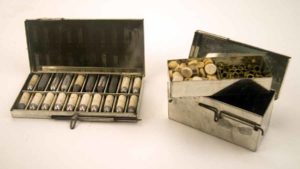
Tools of the Trade
While the Enfield or Springfield muskets that were issued often came with little more than a bayonet or a sling, Confederate sharpshooters fortunate enough to possess a Whitworth required several vital accoutrements to maintain their precision arm.
Bullet Tins
The storage of Whitworth bullets prepared for shooting could take the form of containers like these reproductions of original Whitworth tins. Capable of holding lubricated/patched projectiles, wads and percussion caps—these tins aided in organizing and maintaining accurate ammunition.
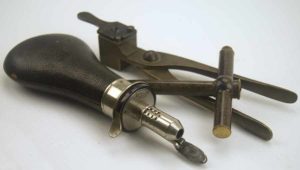
Powder Flask/Combination Tool
Exact powder charges could be thrown consistently using this leather-covered adjustable flask, increasing potential accuracy. If a heavier charge was needed, the flask tip could be adjusted to increase how much powder was thrown. A combination tool holding a percussion cone wrench, accessory screwdriver tips, and an oiler helped maintain a rifle at peak efficiency. Cone protectors could be fashioned in the field from a carved bullet.
Bullet Molds
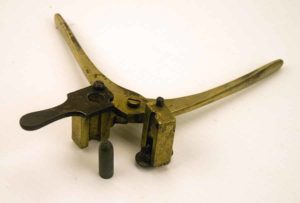
A limited amount of Whitworth ammunition was imported in the form of loaded cartridges and projectiles prepared in British factories. These paper cartridges were fragile and easily damaged in the field. Bullet molds were also included in each shipment of rifles. Confederate arsenals generally cast bullets, as the industrial machinery to swage hexagonal projectiles was not available. Cylindrical bullet molds were the most commonly encountered, but expedient hexagonal bullet molds could be constructed using a section of barrel. Markings on the mold would indicate the caliber and bullet weight. The lead–tin mixture used in casting would determine the hardness of the projectiles and also their weight. Whitworth bullet molds were similar in pattern to Enfield molds, being carefully constructed of bronze alloy, with an iron spruce cutter and base plug. –D.W. & M.W.
When issued, the rifles came with specific rules of engagement. The Whitworth sharpshooter would only use his gun against high-value targets. Artillery positions, cavalry scouts, exposed officers, and enemy sharpshooters were fair game. Furthermore, they were free to operate independently, choosing their own targets and locations on the battlefield. Some Confederate generals—especially Maj. Gen. Patrick Cleburne of the Army of Tennessee—consolidated their sharpshooters into dedicated companies, using them to divert enemy forces where needed.
While many high-ranking Union officers had fallen victim to sharpshooters armed with Whitworth rifles, Maj. Gen. John Sedgwick, in command of the 6th Corps at Spotsylvania, was the most noteworthy witness to their effectiveness. Sedgwick was no stranger to enemy bullets, having been wounded several times prior to Spotsylvania. Ironically, he was hit but not injured by a spent bullet on May 8, 1864. The next day, his luck ran out.
The conditions the morning of May 9 were practically perfect for a sharpshooter. Sedgwick’s headquarters near the fork of the Brock Road was just 100 feet behind the Union’s front line. There the Federal forces had pushed forward into a convex angle, until less than 900 yards separated the opposing armies. Artillery and infantry positions slowly adjusted as the two Union corps merged on the Brock Road, further enhancing the target-rich environment.
[quote style=”boxed” float=”left”]Sedgwick chided veteran soldiers with assurances that confederate shooters ‘couldn’t hit an elephant at this distance[/quote]
Sedgwick was in the middle of it all. It was 9:15 a.m., and he had just sat down to breakfast—a simple cup of coffee. In a jovial mood, he joked with his staff, teasing a colonel laboring to fill his pipe.
Bullets from the Confederate infantry constantly whistled overhead, a handful of better-aimed shots striking closer. One hundred yards from Sedgwick, Colonel Frederick T. Locke was wounded by a sharpshooter, but Sedgwick evidently didn’t care. Generals Grant and Meade rode by and asked if he wanted to travel along the lines. Sedgwick declined, electing to stay with his men to adjust an infantry position that was in danger of overlapping his artillery.
As the general walked to the point of concern, the enemy fire intensified. Veteran soldiers nearby ducked for cover; however, Sedgwick stood firm, chiding them with assurances that the Confederate shooters “couldn’t hit an elephant at this distance.” Ignoring pleas from his troops to leave the field of fire, the general stepped between two cannon of the 1st Massachusetts Volunteer Heavy Artillery and repeated his earlier observation: “They couldn’t hit an elephant at this distance.”
According to eyewitnesses, at 9:45 a.m., they heard the distinctive “whistle” of a Whitworth projectile, and next, the dull thud of the round hitting Sedgwick in the face. As he slowly slumped to the ground, the bullet hole was plainly visible below his left eye.
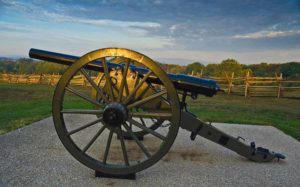
A “Sharpshooter” Cannon
Whitworth’s obsession with precision led to his creation of an extremely accurate breech-loading 12-pounder rifled cannon of significantly advanced design for that era of mainly muzzle-loading cannons. Whitworth’s 2.75-inch hexagonal bore light field gun, in effect, was a “cannon-sized” version of his superbly accurate rifle.
Whitworth constructed his sleek, almost delicate-looking, cannon of steel, making it lighter than the Civil War’s ubiquitous bronze Napoleon 12-pounder howitzer. Yet it was the Whitworth’s accuracy that most distinguished it from other Civil War–era cannons. An 1864 engineering magazine noted that: “At 1,600 yards, the Whitworth gun fired ten shots with a lateral deviation of only 5 inches.” That degree of accuracy earned it a reputation as the artilleryman’s equivalent of a sharpshooter’s rifle. It also made the Whitworth cannon a deadly counter-battery weapon targeting enemy artillery; but its relatively small shell prevented it from being an effective anti-infantry cannon. Moreover, like its Whitworth rifle counterpart, the cannon was subject to black powder fouling, causing the breech-loading mechanism to jam.
Specifications
» Barrel Weight 1,092 lbs< /br>
» Barrel Length 104 inches< /br>
» Barrel Material Steel< /br>
» Projectile 12 lbs.–11 oz. hexagonal bolt< /br>
» Propellant Charge 1.75 lbs of black powder< /br>
» Muzzle Velocity 1,500 ft./sec.< /br>
» Maximum Range 10,000 yards (about 6 miles)< /br>
» Manufactured by Whitworth Ordnance Company, Manchester, England< /br>
» Number Used in Civil War Approx. 50 (most CSA; one battery USA)
Lieutenant General Ulysses Grant, general-in-chief of the Union Army, equated Sedgwick’s loss to an entire division of men. Although it has never been definitively tied to a specific Confederate marksman, his death was certainly the culmination of one sharpshooter’s mission: the elimination of a high-value target using an uncommonly accurate firearm.
Today, examples of Civil War–used Whitworths are exceedingly scarce. Naturally, some Confederate sharpshooters hid theirs and brought them home instead of surrendering them at the war’s end, but the Whitworth’s presence in the Civil War was generally slight to begin with. Other than in museums and choice private collections, not many exist.
The Whitworth was nevertheless among the most feared firearms to serve in the Civil War. Arguably the first true sniper rifle by design, it was capable of feats previously thought impossible, as Sedgwick’s fate so aptly demonstrates. Indeed, its future implications were profound, for this little-known rifle of the Confederacy signaled the dawn of a new species of combat; a modern warfare in which marksmen could kill from great distances with seeming impunity.
Doug Wicklund is senior curator for the NRA Firearms Museums. His collecting and shooting of antique arms is tempered by his growing accumulation of Civil War–era diaries, including sharpshooter journals.
Michael Williams is a regular contributor to America’s Civil War. When he’s not writing about military history and firearms, he enjoys hunting and long-range shooting.

